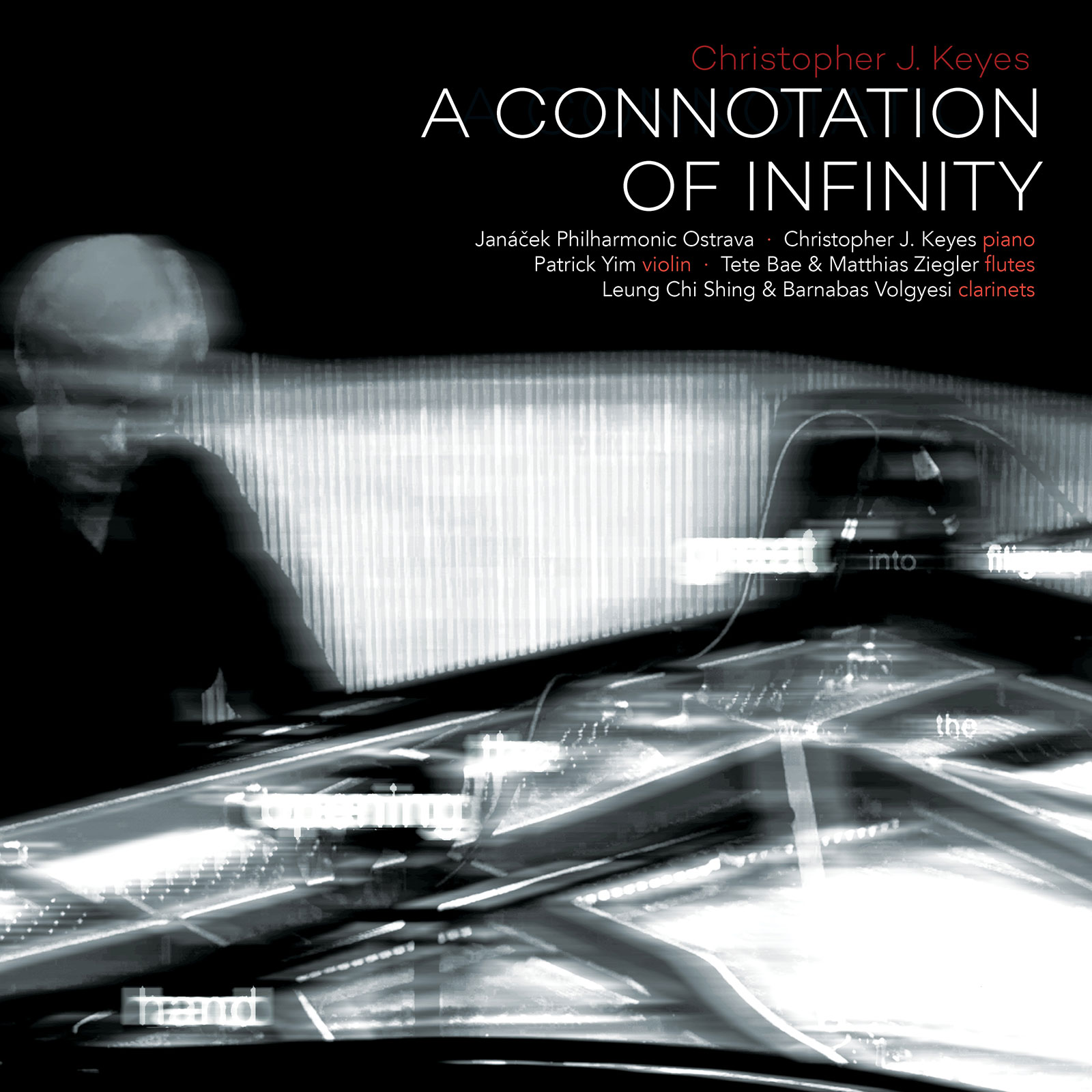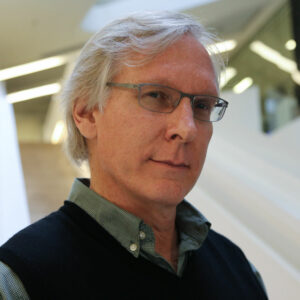
Share Album:
DVD & Blu-ray in 5.1 surround-sound
A Connotation of Infinity
Christopher J. Keyes composer
Janáček Philharmonic Ostrava
Christopher J. Keyes piano
Patrick Yim violin
Tete Bae & Matthias Ziegler flutes
Leung Chi Shing & Barnabas Volgyesi clarinets
Christopher J. Keyes’s new album, Ravello Records’ A CONNOTATION OF INFINITY, speaks directly to why listeners should embrace the transgressive element of electronics in traditional classical music. Keyes, who wrote as much software for the album as he did music, employs what he calls a 3D audio for a more immersive listening experience. Keyes’s latest release, which features performances of select pieces on video, envelopes and entrances the minds of listeners from all walks of life.
The album opens with the 17+ minute epic Of Worlds Beyond. Performed by an orchestra, the composition possesses a well-rounded quality of sound. Another unique feature in Keyes’s album is the use of non-musical elements to influence the piece. In Four Improvisations on Cummings, the composer uses keyboard sensors to detect pitch and dynamics that, when played, subsequently trigger text from poems in E.E. Cummings’ collection “Tulips and Chimneys." Resonant Passages features images and sounds of Hong Kong traffic as an accent to the composition’s reflection on how streams of images and sounds resonate with us as listeners and human beings.
In some compositions, the piano gives way to other instruments that star the show. Antiphon In Memory of Pierre Boulez, for instance, is a piece written for two flutes and two clarinets, paying homage to the late composer through the minimalist use of processing available in Boulez’ time. Tree of Remembrance features only violin and tape. An homage to Henri Dutilleux, Keyes wrote the composition to loosely mirror Dutilleux’s violin concerto “L'Arbre Des Songs."
A CONNOTATION OF INFINITY pushes boundaries and opens listeners to new experiences, both audially and visually. Don’t miss the chance to be a part of this riveting performance.
Listen
Stream/Buy
Choose your platform
Track Listing & Credits
| # | Title | Composer | Performer | |
|---|---|---|---|---|
| 01 | Of the Worlds Beyond | Christopher J. Keyes | Janáček Philharmonic Ostrava | Jiří Petrdlík, conductor | 17:51 |
| 02 | A Distance Up Close | Christopher J. Keyes | Christopher J. Keyes, piano | 9:48 |
| 03 | Tree of Remembrance | Christopher J. Keyes | Patrick Yim, violin | 8:00 |
| 04 | Antiphon in Memory of Pierre Boulez | Christopher J. Keyes | Tete Bae, flute; Matthias Ziegler, flutes Leung Chi Shing, clarinet; Barnabás Völgyes, clarinet | 13:15 |
| 05 | Resonant Passages | Christopher J. Keyes | Christopher J. Keyes, piano | 9:04 |
| 06 | Minimal Colors | Christopher J. Keyes | Christopher J. Keyes, piano | 7:31 |
| DVD & BLU-RAY ONLY: | ||||
| Four Improvisations on Cummings: in just-spring | Christopher J. Keyes | Christopher J. Keyes, piano | ||
| Four Improvisations on Cummings: a connotation of infinity | Christopher J. Keyes | Christopher J. Keyes, piano | ||
| Four Improvisations on Cummings: there is a moon sole in the blue | Christopher J. Keyes | Christopher J. Keyes, piano | ||
| Four Improvisations on Cummings: always before your voice my soul | Christopher J. Keyes | Christopher J. Keyes, piano |
OF THE WORLDS BEYOND (TRACK 1)
Recorded February 22, 2019 at Dům Kultury in Ostrava, Czech Republic
Session producer Jan Košulič
Co-producer Bob Lord
Session Engineer Pavel Kunčar
Assistant Engineer Maroš Hlatký
TRACKS 2 TO 10
Recorded April 2019 at the Laboratory for Immersive Arts and Technology, HKBU, in Hong Kong
Recording Session Engineer Lai Ching Kong
DVD AND BLU-RAY CREDITS
Videography & post-production (video) Hari Ravi
Interactive graphics & post-production (audio) Christopher J. Keyes
Executive Producer Bob Lord
Executive A&R Sam Renshaw
A&R Director Brandon MacNeil
A&R Quinton Blue
VP, Audio Production Jeff LeRoy
Recording Sessions Manager Levi Brown
Recording Sessions Assistant Emma Terrell
Audio Director Lucas Paquette
Editing & Mixing (track 1), Mastering Jan Košulič
VP, Design & Marketing Brett Picknell
Art Director Ryan Harrison
Design Edward A. Fleming
Addt’l Video Post-Production Ty Ueda
Publicity Patrick Niland, Sara Warner
Artist Information

Christopher J. Keyes
Acclaimed by Fanfare Magazine as “Masterful...a modernized Rachmaninoff” Christopher J. Keyes (b. 1963) began his career as a pianist, winning many competitions and later making his “double-debut” in Carnegie Hall as both soloist and guest composer with the New York Youth Symphony. He began formal composition lessons at the University of California at Santa Barbara, earning a B.M. in Piano Performance and a B.A. in Creative Studies with an emphasis in composition. He continued his musical training at the Eastman School of Music, completing his doctorate in 1992. His major composition teachers include Joseph Schwantner, Samuel Adler, Christopher Rouse, and Robert Morris. Among his numerous awards are the Eastman Szernovsky Award, several ASCAP Grants to Young Composers, and the Rudolf Nissim Award for best orchestral work written by a living ASCAP member. He is also an author of various scholarly articles on subjects including audio engineering, the pedagogy of composition, and music technology.
Notes
A CONNOTATION OF INFINITY
I confess, despite being a standard-repertoire/traditionally-trained pianist, at some point I started becoming bored with piano recitals. Even as a student, I wanted to bring to it something new, and not only just new repertoire. I wanted to bring to it a more immersive experience. Beginning in the late 1980s, I started using stage lighting as a new element. Shortly after that, I started composing electro-acoustic “tape” music played as a background layer underneath the solo pianist (me). In the late 1990s I started using real-time multi-channel DSP (digital signal processing) in concerts, miking the piano, processing it, and sending it out to eight or more loudspeakers surrounding the audience. That was a much more immersive experience. At that time, I also started writing my own software for real-time DSP, writing programs specific to each new piece. Finally, in the mid 2000s, I became interested in real-time image processing as well.
This has led to my most recent work, presented here. Each piece incorporates some or all of the interests above. At the heart of all of these pieces, however, is still the versatility and expressiveness of traditional acoustic instruments. Combined with technology, the pieces are an attempt to expand what these instruments can do in concerts and on recordings.
— Christopher J. Keyes
